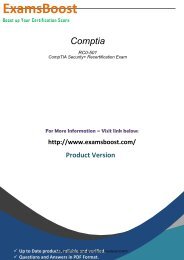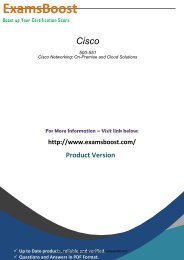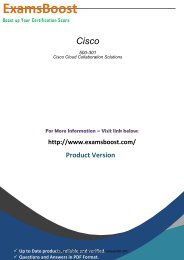Cisco 300-115 Exam Dumps 2018
Study kits and preparation materials provided by us for 300-115 Test are authorized by the professionals and industry experts. You can easily pass your certification test with our brain dumps and PDF sample questions. For more info please visit here: http://www.examsboost.com/test/300-115/
Study kits and preparation materials provided by us for 300-115 Test are authorized by the professionals and industry experts. You can easily pass your certification test with our brain dumps and PDF sample questions. For more info please visit here: http://www.examsboost.com/test/300-115/
Create successful ePaper yourself
Turn your PDF publications into a flip-book with our unique Google optimized e-Paper software.
<strong>Exam</strong>sBoost<br />
Boost up Your Certification Score<br />
<strong>Cisco</strong><br />
<strong>300</strong>-<strong>115</strong><br />
Implementing <strong>Cisco</strong> IP Switched Networks (SWITCH )<br />
For More Information – Visit link below:<br />
http://www.examsboost.com/<br />
Product Version<br />
Up to Date products, reliable and verified.<br />
Questions and Answers in PDF Format.<br />
Visit us athttps://www.examsboost.com/test/<strong>300</strong>-<strong>115</strong>/
Question: 1<br />
What is the maximum number of switches that can be stacked using <strong>Cisco</strong> StackWise?<br />
A. 4<br />
B. 5<br />
C. 8<br />
D. 9<br />
E. 10<br />
F. 13<br />
Question: 2<br />
Answer: D<br />
A network engineer wants to add a new switch to an existing switch stack. Which configuration must be<br />
added to the new switch before it can be added to the switch stack?<br />
A. No configuration must be added.<br />
B. stack ID<br />
C. IP address<br />
D. VLAN information<br />
E. VTP information<br />
Question: 3<br />
Answer: A<br />
What percentage of bandwidth is reduced when a stack cable is broken?<br />
A. 0<br />
B. 25<br />
C. 50<br />
D. 75<br />
E. 100<br />
Question: 4<br />
Answer: C<br />
Visit us athttps://www.examsboost.com/test/<strong>300</strong>-<strong>115</strong>/
Refer to the exhibit.<br />
Which set of configurations will result in all ports on both switches successfully bundling into an<br />
EtherChannel?<br />
A. switch1<br />
channel-group 1 mode active<br />
switch2<br />
channel-group 1 mode auto<br />
B. switch1<br />
channel-group 1 mode desirable<br />
switch2<br />
channel-group 1 mode passive<br />
C. switch1<br />
channel-group 1 mode on<br />
switch2<br />
channel-group 1 mode auto<br />
D. switch1<br />
channel-group 1 mode desirable<br />
switch2<br />
channel-group 1 mode auto<br />
Question: 5<br />
Answer: D<br />
Refer to the exhibit.<br />
Visit us athttps://www.examsboost.com/test/<strong>300</strong>-<strong>115</strong>/
How can the traffic that is mirrored out the GigabitEthernet0/48 port be limited to only traffic that is<br />
received or transmitted in VLAN 10 on the GigabitEthernet0/1 port?<br />
A. Change the configuration for GigabitEthernet0/48 so that it is a member of VLAN 10.<br />
B. Add an access list to GigabitEthernet0/48 to filter out traffic that is not in VLAN 10.<br />
C. Apply the monitor session filter globally to allow only traffic from VLAN 10.<br />
D. Change the monitor session source to VLAN 10 instead of the physical interface.<br />
Question: 6<br />
Answer: C<br />
Refer to the exhibit.<br />
A network engineer wants to analyze all incoming and outgoing packets for an interface that is<br />
connected to an access switch. Which three items must be configured to mirror traffic to a packet sniffer<br />
that is connected to the distribution switch? (Choose three.)<br />
A. A monitor session on the distribution switch with a physical interface as the source and the remote<br />
SPAN VLAN as the destination<br />
B. A remote SPAN VLAN on the distribution and access layer switch<br />
C. A monitor session on the access switch with a physical interface source and the remote SPAN VLAN as<br />
the destination<br />
D. A monitor session on the distribution switch with a remote SPAN VLAN as the source and physical<br />
interface as the destination<br />
Visit us athttps://www.examsboost.com/test/<strong>300</strong>-<strong>115</strong>/
E. A monitor session on the access switch with a remote SPAN VLAN source and the physical interface as<br />
the destination<br />
F. A monitor session on the distribution switch with a physical interface as the source and a physical<br />
interface as the destination<br />
Question: 7<br />
Answer: B, C, D<br />
After an EtherChannel is configured between two <strong>Cisco</strong> switches, interface port channel 1 is in the<br />
down/down state. Switch A is configured with channel-group 1 mode active, while Switch B is<br />
configured with channel-group 1 mode desirable. Why is the EtherChannel bundle not working?<br />
A. The switches are using mismatched EtherChannel negotiation modes.<br />
B. The switch ports are not configured in trunking mode.<br />
C. LACP priority must be configured on both switches.<br />
D. The channel group identifier must be different for Switch A and Switch B.<br />
Question: 8<br />
Answer: A<br />
An EtherChannel bundle has been established between a <strong>Cisco</strong> switch and a corporate web server. The<br />
network administrator noticed that only one of the EtherChannel links is being utilized to reach the web<br />
server. What should be done on the <strong>Cisco</strong> switch to allow for better EtherChannel utilization to the<br />
corporate web server?<br />
A. Enable <strong>Cisco</strong> Express Forwarding to allow for more effective traffic sharing over the EtherChannel<br />
bundle.<br />
B. Adjust the EtherChannel load-balancing method based on destination IP addresses.<br />
C. Disable spanning tree on all interfaces that are participating in the EtherChannel bundle.<br />
D. Use link-state tracking to allow for improved load balancing of traffic upon link failure to the server.<br />
E. Adjust the EtherChannel load-balancing method based on source IP addresses.<br />
Question: 9<br />
Answer: E<br />
Interface FastEthernet0/1 is configured as a trunk interface that allows all VLANs. This command is<br />
configured globally:<br />
monitor session 2 filter vlan 1 - 8, 39, 52<br />
What is the result of the implemented command?<br />
Visit us athttps://www.examsboost.com/test/<strong>300</strong>-<strong>115</strong>/
A. All VLAN traffic is sent to the SPAN destination interface.<br />
B. Traffic from VLAN 4 is not sent to the SPAN destination interface.<br />
C. Filtering a trunked SPAN port effectively disables SPAN operations for all VLANs.<br />
D. The trunk's native VLAN must be changed to something other than VLAN 1.<br />
E. Traffic from VLANs 1 to 8, 39, and 52 is replicated to the SPAN destination port.<br />
Question: 10<br />
Answer: E<br />
A network engineer notices inconsistent <strong>Cisco</strong> Discovery Protocol neighbors according to the diagram<br />
that is provided. The engineer notices only a single neighbor that uses <strong>Cisco</strong> Discovery Protocol, but it<br />
has several routing neighbor relationships. What would cause the output to show only the single<br />
neighbor?<br />
A. The routers are connected via a Layer 2 switch.<br />
B. IP routing is disabled on neighboring devices.<br />
C. <strong>Cisco</strong> Express Forwarding is enabled locally.<br />
D. <strong>Cisco</strong> Discovery Protocol advertisements are inconsistent between the local and remote devices.<br />
Question: 11<br />
Answer: A<br />
After the implementation of several different types of switches from different vendors, a network<br />
engineer notices that directly connected devices that use <strong>Cisco</strong> Discovery Protocol are not visible. Which<br />
vendor-neutral protocol could be used to resolve this issue?<br />
A. Local Area Mobility<br />
B. Link Layer Discovery Protocol<br />
C. NetFlow<br />
D. Directed Response Protocol<br />
Question: 12<br />
Answer: B<br />
Several new switches have been added to the existing network as VTP clients. All of the new switches<br />
have been configured with the same VTP domain, password, and version. However, VLANs are not<br />
passing from the VTP server (existing network) to the VTP clients. What must be done to fix this?<br />
Visit us athttps://www.examsboost.com/test/<strong>300</strong>-<strong>115</strong>/
A. Remove the VTP domain name from all switches with "null" and then replace it with the new domain<br />
name.<br />
B. Configure a different native VLAN on all new switches that are configured as VTP clients.<br />
C. Provision one of the new switches to be the VTP server and duplicate information from the existing<br />
network.<br />
D. Ensure that all switch interconnects are configured as trunks to allow VTP information to be<br />
transferred.<br />
Question: 13<br />
Answer: D<br />
After implementing VTP, the extended VLANs are not being propagated to other VTP switches. What<br />
should be configured for extended VLANs?<br />
A. VTP does not support extended VLANs and should be manually added to all switches.<br />
B. Enable VTP version 3, which supports extended VLAN propagation.<br />
C. VTP authentication is required when using extended VLANs because of their ability to cause network<br />
instability.<br />
D. Ensure that all switches run the same <strong>Cisco</strong> IOS version. Extended VLANs will not propagate to<br />
different IOS versions when extended VLANs are in use.<br />
Question: 14<br />
Answer: B<br />
Refer to the exhibit.<br />
Switch A, B, and C are trunked together and have been properly configured for VTP. Switch C receives<br />
VLAN information from the VTP server Switch A, but Switch B does not receive any VLAN information.<br />
What is the most probable cause of this behavior?<br />
A. Switch B is configured in transparent mode.<br />
B. Switch B is configured with an access port to Switch A, while Switch C is configured with a trunk port<br />
to Switch B.<br />
C. The VTP revision number of the Switch B is higher than that of Switch A.<br />
Visit us athttps://www.examsboost.com/test/<strong>300</strong>-<strong>115</strong>/
D. The trunk between Switch A and Switch B is misconfigured.<br />
Answer: A<br />
Question: 15<br />
Refer to the exhibit.<br />
Switch A, B, and C are trunked together and have been properly configured for VTP. Switch B has all<br />
VLANs, but Switch C is not receiving traffic from certain VLANs. What would cause this issue?<br />
A. A VTP authentication mismatch occurred between Switch A and Switch B.<br />
B. The VTP revision number of Switch B is higher than that of Switch A.<br />
C. VTP pruning is configured globally on all switches and it removed VLANs from the trunk interface that<br />
is connected to Switch C.<br />
D. The trunk between Switch A and Switch B is misconfigured.<br />
Question: 16<br />
Answer: C<br />
After the recent upgrade of the switching infrastructure, the network engineer notices that the port<br />
roles that were once "blocking" are now defined as "alternate" and "backup." What is the reason for this<br />
change?<br />
A. The new switches are using RSTP instead of legacy IEEE 802.1D STP.<br />
B. IEEE 802.1D STP and PortFast have been configured by default on all newly implemented <strong>Cisco</strong><br />
Catalyst switches.<br />
C. The administrator has defined the switch as the root in the STP domain.<br />
D. The port roles have been adjusted based on the interface bandwidth and timers of the new <strong>Cisco</strong><br />
Catalyst switches.<br />
Answer: A<br />
Visit us athttps://www.examsboost.com/test/<strong>300</strong>-<strong>115</strong>/
Question: 17<br />
An administrator recently configured all ports for rapid transition using PortFast. After testing, it has<br />
been determined that several ports are not transitioning as they should. What is the reason for this?<br />
A. RSTP has been enabled per interface and not globally.<br />
B. The STP root bridge selection is forcing key ports to remain in non-rapid transitioning mode.<br />
C. STP is unable to achieve rapid transition for trunk links.<br />
D. The switch does not have the processing power to ensure rapid transition for all ports.<br />
Question: 18<br />
Answer: C<br />
Which technique automatically limits VLAN traffic to only the switches that require it?<br />
A. access lists<br />
B. DTP in nonegotiate<br />
C. VTP pruning<br />
D. PBR<br />
Question: 19<br />
Answer: C<br />
What effect does the mac address-table aging-time 180 command have on the MAC address-table?<br />
A. This is how long a dynamic MAC address will remain in the CAM table.<br />
B. The MAC address-table will be flushed every 3 minutes.<br />
C. The default timeout period will be 360 seconds.<br />
D. ARP requests will be processed less frequently by the switch.<br />
E. The MAC address-table will hold addresses 180 seconds longer than the default of 10 minutes.<br />
Question: 20<br />
Answer: A<br />
While working in the core network building, a technician accidently bumps the fiber connection<br />
between two core switches and damages one of the pairs of fiber. As designed, the link was placed into<br />
Visit us athttps://www.examsboost.com/test/<strong>300</strong>-<strong>115</strong>/
a non-forwarding state due to a fault with UDLD. After the damaged cable was replaced, the link did not<br />
recover. What solution allows the network switch to automatically recover from such an issue?<br />
A. macros<br />
B. errdisable autorecovery<br />
C. IP Event Dampening<br />
D. command aliases<br />
E. Bidirectional Forwarding Detection<br />
Question: 21<br />
Answer: B<br />
A network engineer deployed a switch that operates the LAN base feature set and decides to use the<br />
SDM VLAN template. The SDM template is causing the CPU of the switch to spike during peak working<br />
hours. What is the root cause of this issue?<br />
A. The VLAN receives additional frames from neighboring switches.<br />
B. The SDM VLAN template causes the MAC address-table to overflow.<br />
C. The VLAN template disables routing in hardware.<br />
D. The switch needs to be rebooted before the SDM template takes effect.<br />
Question: 22<br />
Answer: C<br />
An access switch has been configured with an EtherChannel port. After configuring SPAN to monitor this<br />
port, the network administrator notices that not all traffic is being replicated to the management server.<br />
What is a cause for this issue?<br />
A. VLAN filters are required to ensure traffic mirrors effectively.<br />
B. SPAN encapsulation replication must be enabled to capture EtherChannel destination traffic.<br />
C. The port channel can be used as a SPAN source, but not a destination.<br />
D. RSPAN must be used to capture EtherChannel bidirectional traffic.<br />
Question: 23<br />
Answer: C<br />
Refer to the exhibit.<br />
Visit us athttps://www.examsboost.com/test/<strong>300</strong>-<strong>115</strong>/
What is the result of the configuration?<br />
A. The EtherChannels would not form because the load-balancing method must match on the devices.<br />
B. The EtherChannels would form and function properly even though the load-balancing and<br />
EtherChannel modes do not match.<br />
C. The EtherChannels would form, but network loops would occur because the load-balancing methods<br />
do not match.<br />
D. The EtherChannels would form and both devices would use the dst-ip load-balancing method because<br />
Switch1 is configured with EtherChannel mode active.<br />
Question: 24<br />
Answer: B<br />
A network engineer tries to configure storm control on an EtherChannel bundle. What is the result of<br />
the configuration?<br />
A. The storm control settings will appear on the EtherChannel, but not on the associated physical ports.<br />
B. The configuration will be rejected because storm control is not supported for EtherChannel.<br />
C. The storm control configuration will be accepted, but will only be present on the physical interfaces.<br />
D. The settings will be applied to the EtherChannel bundle and all associated physical interfaces.<br />
Question: 25<br />
Answer: D<br />
Visit us athttps://www.examsboost.com/test/<strong>300</strong>-<strong>115</strong>/
What is the function of NSF?<br />
A. forward traffic simultaneously using both supervisors<br />
B. forward traffic based on <strong>Cisco</strong> Express Forwarding<br />
C. provide automatic failover to back up supervisor in VSS mode<br />
D. provide nonstop forwarding in the event of failure of one of the member supervisors<br />
Question: 26<br />
Answer: D<br />
After UDLD is implemented, a Network Administrator noticed that one port stops receiving UDLD<br />
packets. This port continues to reestablish until after eight failed retries. The port then transitions into<br />
the errdisable state. Which option describes what causes the port to go into the errdisable state?<br />
A. Normal UDLD operations that prevent traffic loops.<br />
B. UDLD port is configured in aggressive mode.<br />
C. UDLD is enabled globally.<br />
D. UDLD timers are inconsistent.<br />
Question: 27<br />
Answer: B<br />
After reviewing UDLD status on switch ports, an engineer notices that the." Which statement describes<br />
what this indicates about the status of the port?<br />
A. The port is fully operational and no known issues are detected.<br />
B. The bidirectional status of "unknown" indicates that the port will go into the disabled state because it<br />
stopped receiving UDLD packets from its neighbor.<br />
C. UDLD moved into aggressive mode after inconsistent acknowledgements were detected.<br />
D. The UDLD port is placed in the "unknown" state for 5 seconds until the next UDLD packet is received<br />
on the interface.<br />
Question: 28<br />
Answer: A<br />
Pilot testing of the new switching infrastructure finds that when the root port is lost, STP immediately<br />
replaces the root port with an alternative root port. Which spanning-tree technology is used to<br />
accomplish backup root port selection?<br />
Visit us athttps://www.examsboost.com/test/<strong>300</strong>-<strong>115</strong>/
A. PVST+<br />
B. PortFast<br />
C. BackboneFast<br />
D. UplinkFast<br />
E. Loop Guard<br />
F. UDLD<br />
Answer: D<br />
Question: 29<br />
A network engineer must adjust the STP interface attributes to influence root port selection. Which two<br />
elements are used to accomplish this? (Choose two.)<br />
A. port-priority<br />
B. cost<br />
C. forward-timers<br />
D. link type<br />
E. root guard<br />
Question: 30<br />
Answer: A, B<br />
A network engineer must set the load balance method on an existing port channel. Which action must<br />
be done to apply a new load balancing method?<br />
A. Configure the new load balancing method using port-channel load-balance.<br />
B. Adjust the switch SDM back to "default".<br />
C. Ensure that IP CEF is enabled globally to support all load balancing methods.<br />
D. Upgrade the PFC to support the latest load balancing methods.<br />
Answer: A<br />
Visit us athttps://www.examsboost.com/test/<strong>300</strong>-<strong>115</strong>/
Powered by TCPDF (www.tcpdf.org)<br />
Thank You for Trying Our Product<br />
For More Information – Visit link below:<br />
http://www.examsboost.com/<br />
FEATURES<br />
90 Days Free Updates<br />
Money Back Pass Guarantee<br />
Instant Download or Email Attachment<br />
24/7 Live Chat Support<br />
PDF file could be used at any Platform<br />
50,000 Happy Customer<br />
Visit us athttps://www.examsboost.com/test/<strong>300</strong>-<strong>115</strong>/


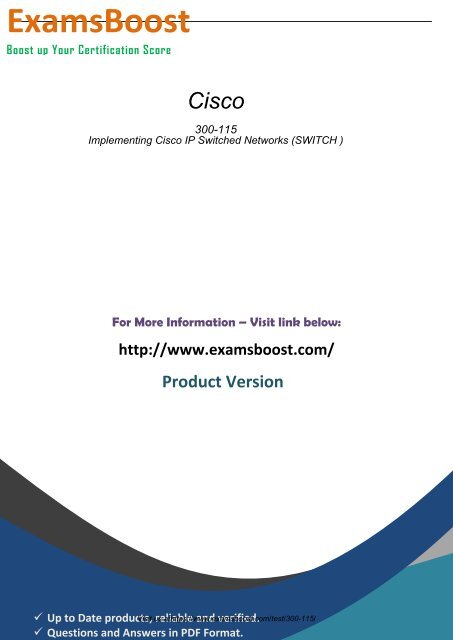
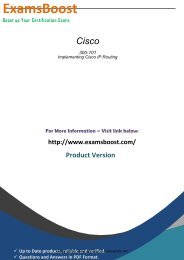
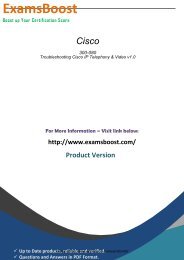
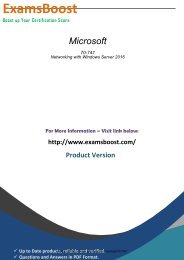
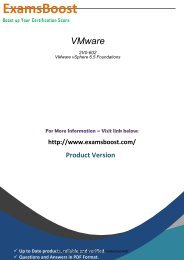
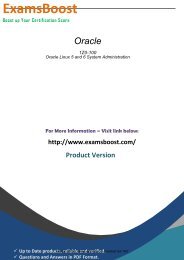

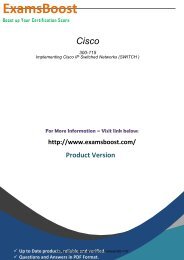
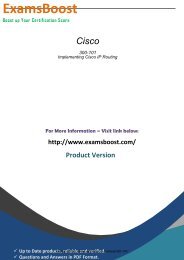
![Cisco 300-075 [2018] Updated 300-075 Dumps PDF by ExamsBoost](https://img.yumpu.com/59900470/1/184x260/cisco-300-075-2018-updated-300-075-dumps-pdf-by-examsboost.jpg?quality=85)


